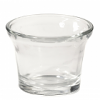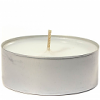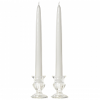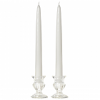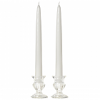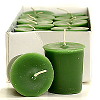5 Easy Ways to Reduce Candle Soot
One of the most common complaints about candles of all kinds is that sometimes they soot. There are a number of ways to greatly reduce the amount of soot coming from your candles which will also help them to burn better. Today I will share some tips on burning candles to help you have a better experience with your candles and save money. First let's take a look at what causes soot from a candle flame.
Why Do Candles Soot?
Soot from a candle is caused when there is incomplete combustion of the fuel. Incomplete combustion can be caused by a number of different factors. Two of these factors are the balance between the wax and wick in the candle and disturbing the candle flame. The fuel to the candle flame is the liquid wax which is being drawn up through the wick. Once the flame of the candle has started drawing the liquid candle wax up the wick, it does so at a steady rate. When the flame of the candle is disturbed the size of the flame changes and the amount of fuel being used is no longer consistent. If there is too much fuel for the flame to use it is put off in the form of soot.
Keep Candles Out of Drafty Areas
Burning candles near air vents, fans, or open windows will cause your candle to produce soot. When a breeze causes the candle flame to bounce around, its size changes. A still flame will use a consistent amount of fuel. A flame that is bouncing around will draw fuel up the wick at a variable rate, sometimes too much, other times, not enough. When a too much oil is drawn into the wick and then the flame size shrinks, not all the fuel is burned. The extra oil is expelled as soot into the air.
Use Vases and Hurricanes That Are Open On Both Ends
Many event locations, where candles are used for lighting and ambiance, require that the flame of the candle not be exposed above the top of the holder. This could mean the flame of your votive candle must be below the top edge of the glass or that pillars and taper candles need to be in tall cylinders or hurricanes. At first this sounds like a good idea to also keep the draft away from your candles, and it is. However, using a closed bottom cylinder or vase can create problems of its own. Fire needs and uses oxygen to burn. When you have a candle down inside of a container the oxygen is quickly used up and more is needed for the flame to continue burning. More air is sucked into the container through the top but at the same time the warm air heated by the candle flame is trying to get out. The flow of cool air coming into the container fights against the flow of warm air rising out of it. These setup creates a draft inside of the container which produces soot. To reduce the draft created inside of container, use one that is open on both ends. Raise the container up off the table about a half inch using something that can spaced apart so air can get in through the bottom. For my test I used 3 stacks of coins but you should use something more stable.
Put Candle Cappers On Jar Candles
If you are burning jar candles with an opening of about 3" you can purchase candle cappers for less than $4.00. These simple candle accessories separate the warm rising air from the cooler falling air, reducing the turbulence in the jar. Jar candles will usually start to produce more soot the further down into the glass they burn. This is because the flame is getting farther away from the top of the container.
Trim The Wicks
One of the simplest ways to keep candles from producing soot is to trim the wicks. I recommend cutting the wicks to 1/4" for the first lighting. If after a few minutes the flame of the candle looks too big or is bouncing around (while not in a draft) you should cut the wick a little shorter. A burning candle should never be left unattended. If you like to leave your candles burning for a long time the wicks may need to be trimmed again. Don't be afraid to blow a candle out, trim the wick and relight it.
Purchase Quality Candles
Make sure you are getting a quality candle. A well made quality candle doesn't mean expensive, it means well made. Anyone can melt some wax through a string in it and call it a candle. Is it a candle? Yes. Will it burn? Maybe. Should you spend your hard earned money on it? Probably not. The internet is full of pages on which people are selling candles. Type the search term "candles" into Google and you will see there are 1,190,000,000 results. An experienced candle manufacturer will know how to match the wick size, wax type, fragrance, and candle size to produce a great burning candle.

